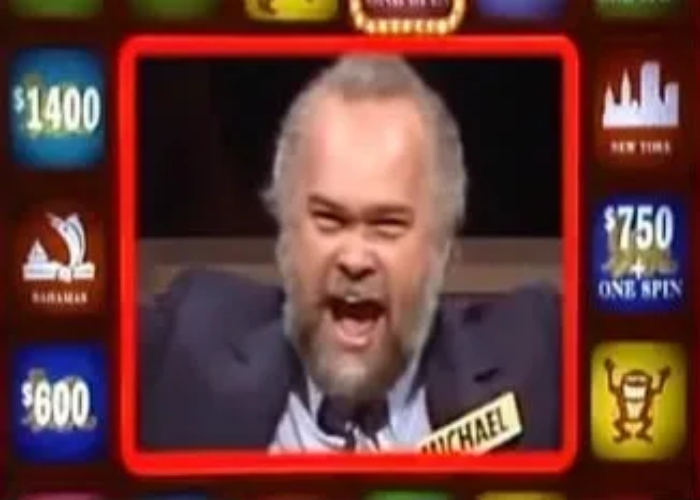
Back in May of 1984, a 35-year-old former ice-cream truck driver from Lebanon Ohio named Michael Larson flew to California to audition for the CBS game show, Press Your Luck. Michael was no ordinary contestant though. He was a man who had spent quite a lot of time studying the show and was more than prepared when he got his break to appear on the show.
Most people who get to be contestants on game shows spend a fair amount of time preparing for them. Larson had went well beyond what a normal contestant would though. He had filled his home with televisions that he never turned off. He would watch for hours on end, trying to find ways to get rich, spending most of his time focusing on infomercial schemes and game shows. After searching for countless hours, he finally found his angle. He would “press his luck” to earn his fortune.
The premise of the Press Your Luck game show was simple. There was a rectangular game board that was filled with squares that indicated different cash amounts. The contestants would take turns “spinning” the game board. The squares would light up in what seemed to be a random order, and the player would press a button to stop the “spin”. Lights would illuminate the square they stopped on, and they won whatever amount was in that square. In addition to cash prizes, there were also other prizes like vacations, pool tables, or sailboats for example. The squares to stay away from though were the “Whammy” squares that featured a little cartoon drawing of a devil that would wipe out their entire winnings. The players would amass as much money and prizes as they could, try to keep their turns going by winning as many free spins as possible and trying to avoid Whammies at all costs.
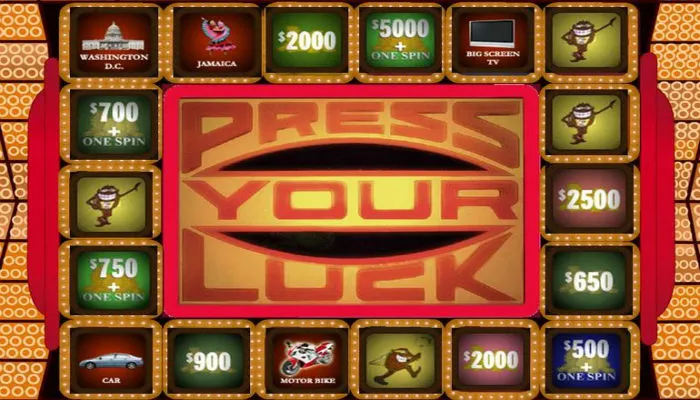
But after watching the show for hours on end, Larson realized that the blinking board wasn’t exactly as unpredictable as it appeared to be. With the use of VCR technology and a whole lot of pausing and rewinding, he discovered that the board followed five distinct patterns, which he was able to memorize. He knew that if he could only get onto the game show, he would be able to control the board in any way he wanted….stopping on big money and free spins without landing on the dreaded Whammies….and he could make a fortune.
Larson didn’t really have any money though, so to even get on the show, he had to borrow airfare from his home in central Ohio to California, and he bought the shirt he wore on the show at a thrift store for just $0.65. With that part of the plan all set, all he had to worry about was actually getting picked to be on the show. He had watched more than enough episodes to know what kind of contestant the producers were looking for. He knew that he couldn’t look cocky or confident, so during the screening process, he acted perky, excited, and self-deprecating. The act worked because he made it onto the show the same day he auditioned. He continued his act from his audition onto the show….being overly excited, bouncing in his seat, cheering on his fellow competitors, and even taking shots at himself when asked personal questions by the host, Peter Tomarken. At one point, Tomarken asked Larson what he’d do with the money if he won, and Larson responded, “hopefully I’ll make enough so I won’t have to drive the ice-cream truck next summer.”
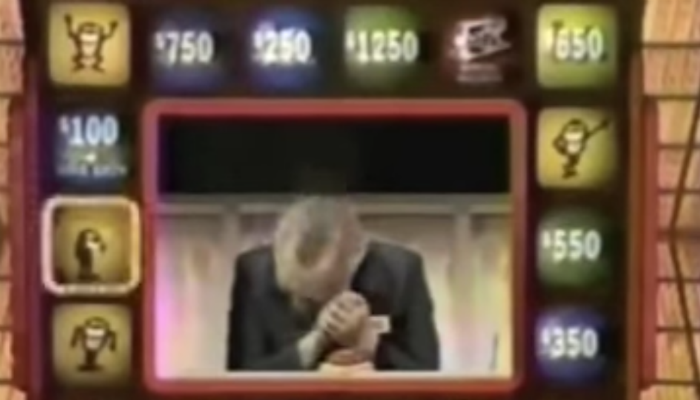
After the first round of generic questions that were always asked in order for the contestants to earn spins, Larson was the first to get his turn on the board. On his first spin, he stopped on a Whammy. This was likely part of his plan to avoid suspicion since he had no money to lose to a Whammy. On his next spins, he collected a modest $2500. His two opponents on the show, Ed Long and Janie Litras, earned $4,080 and $4,608 respectively. That ended the first round, and after a commercial break, it would be Larson’s turn on the board once again. He wouldn’t be so modest with this set of spins.
On his first spin, he hit one of the best spots on the board: $4,000 plus a Free Spin. He followed that up with $5,000 and a Free Spin. Next was $1,000 and a Free Spin. And he just kept going. He spun the board 40 consecutive times, and never hit a Whammy. Not only was he not hitting Whammies, he kept purposely landing on the big money squares that also contained Free Spins. Normally, contestants would hit a Whammy somewhere between 5 and 10 spins, but Larson shattered that average with his amazing performance. When he finally decided to pass his remaining spins, he had racked up $102,851 and a couple of trips and other prizes. The cash amount was so large, the show had to drop the dollar sign from his podium display because it was only designed for 5 digits of earnings, but Larson had shocked the system and ran his winnings up to 6 digits.
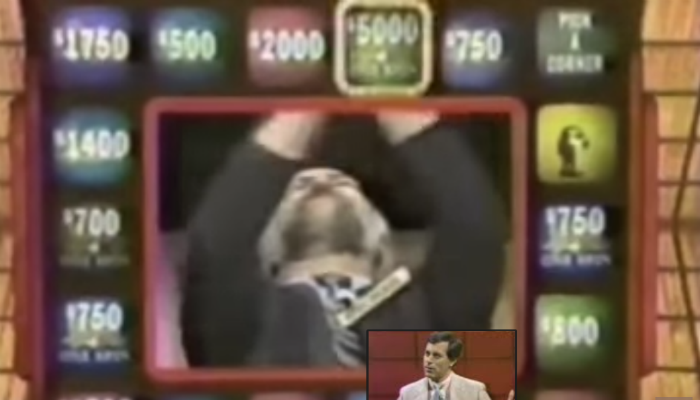
For his first 15 spins or so, the mood on the set was electric. The crowd was cheering him on to keep spinning, his fellow contestants were shocked and amazed at his performance, and host Peter Tomarken was simply astounded. But you know who wasn’t excited? The producers back in the control room, that’s who. It didn’t take very long for the producers to suspect that not all was on the up and up. They quickly assessed that Larson wasn’t just lucky, but that he had some kind of system in play. Unfortunately for them, there wasn’t anything they could do about it because as far as they could tell, he wasn’t breaking any rules.
As Larson continued to rack up the big money and free spins, the mood of his fellow contestants changed. You could see they were losing their patience as all they could do was sit there and watch him play.
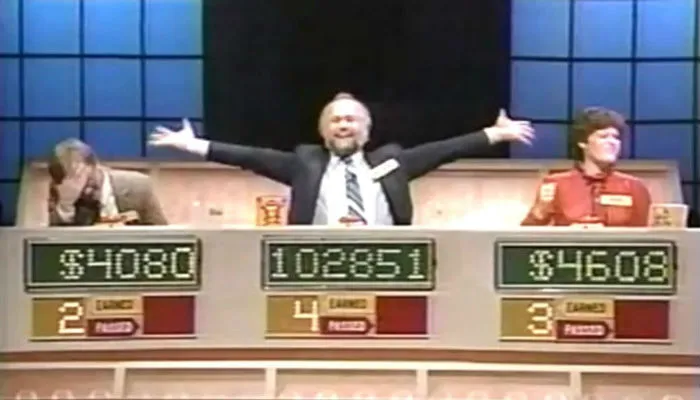
Michael’s turn took so long, that one single half-hour episode couldn’t contain his entire turn, so it had to be broken up into a two-part episode. Even though they weren’t happy with his performance, the producers knew that this was newsworthy, and could potentially be a ratings grabber if advertised correctly. To have enough content from the game to completely fill two episodes, Tomarken recorded an interview with Larson.
Normally, winners on Press Your Luck were invited back on the following episode to defend their title, but that offer was not extended to Michael Larson. CBS rules stated that any contestant who’d won more than $25,000 couldn’t come back. That little rule robbed the world of seeing just how far Michael Larson could go.
The two episodes aired on Friday, June 8, and Monday, June 11, 1984. That was the only time those episodes would see the light of day for almost 20 years. CBS was so embarrassed by what had happened that they locked the episodes away in their vault. In later years, when USA and the Game Show Network bought the syndication rights to air old episodes, CBS refused to let them air the Michael Larson shows.
So What happened to Michael Larson After Press Your Luck?
Since Larson hadn’t really done anything illegal, he was allowed to keep his $110,237, of which he had to pay $30,000 in taxes. After returning home, he put $30,000 into a real estate venture that ended up being a Ponzi Scheme, so he had quickly lost over half of his winnings.
In November of 1984, Larson hit on his next big money-making idea. Every day, a radio station in Dayton Ohio would host a contest where contestants could win a cool $30,000. They would read off a set of serial numbers from a $1 bill, and if you could find the $1 bill with the matching number, you would be the winner. Since the radio station allowed several days to find each bill and collect the winnings, Larson thought he had time to sort through plenty of them and find a winner.
Larson deposited the remainder of his Press Your Luck winnings into several banks, and then withdrew all of it in $1 bills. He had so many bills that he bundled them and stored them in trash bags and burlap sacks. Once he sat down and started sifting through bills looking for winners, it didn’t take long for him to figure out that it would take a week or more just to go through half the money he had on hand. He put half of the money back in the bank and kept about $40,000 on hand for the contest.
Eventually, staring at serial numbers all day can make you tired and cranky, so he and his female friend decided to go see friends at a Christmas party. While they were at the party having a good time, Larson’s house was broken into and robbed, meaning all of that cash was stolen and now gone. Larson suspected that his female friend had a hand in the robbery, and their relationship deteriorated quickly after that. Eventually, after fearing for her life with Larson around, she kicked him out.
Larson bounced around from job to job after that, eventually ending up as an assistant manager of a Wal-Mart. In 1995, he suddenly picked up and left Ohio. Family and friends later discovered that he was under investigation for his part in a lottery scheme that robbed over 20,000 people out of over $3 million dollars. He was never prosecuted for the crime but eventually passed away of throat cancer in 1999.
Remember how I mentioned earlier that CBS locked the episodes away in their vault for almost 20 years? Well, they finally agreed to let them air in 2003. That year, the Game Show Network produced a documentary about Larson’s incredible game called Big Bucks: The Press Your Luck Scandal, which included footage from those episodes.
On the same night the documentary aired, GSN broadcast a special edition of their Press Your Luck revival series called Whammy!. They invited back Larson’s competitors from 1984, Ed Long and Janie Litras. The third contestant on the show was Michael’s brother, James Larson. And wouldn’t you know who won the pony…James Larson walked away as the winner, leaving Long and Litras to feel disappointed at the hands of a Larson once again.
If you would like to relive the incredible series of events on the game show, you can watch both episodes below.

Be the first to comment